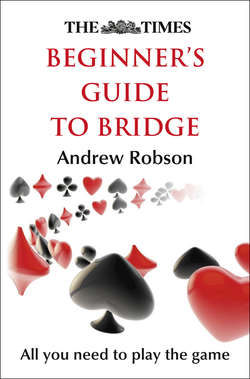Читать книгу The Times Beginner’s Guide to Bridge - Andrew Robson - Страница 33
Opening with a balanced hand
ОглавлениеWith a balanced hand – no void, no singleton and not more than one doubleton – your bidding plan should revolve around no-trumps (see the following panel). The even spread of a balanced hand means you have no strong preference for a trump suit, which is why bidding no-trumps makes sense. However, an opening bid of One no-trump (1NT) shows a specific point count, so you may need to delay your no-trump bid if your point count is higher in order to convey the right message to your partner.
No-trumps
As the name suggests, ‘no-trumps’ means that the deal is played without a trump suit so in each round played the highest card of the lead suit always wins the trick. Arguably it’s slightly more difficult for the declaring side not to have the security of a trump suit, but no-trumps outranks all the trump suits (see the bidding ladder on p. 22 and notice that no-trumps is higher ranked than spades, the highest ranked suit). No-trumps also scores slightly better (see p. 221), so plays a huge role. Typically, a no-trump bid is made when you have no long suit and no short suit – an even spread, or balanced hand. The most important no-trump bid is the opening bid of One no-trump (1NT) because this describes your hand very accurately to your partner. If you open the bidding with 1NT, in most cases you shouldn’t bid again. Having described your hand so accurately, you should leave further bidding decisions to your partner (see p. 35 for your partner’s response to a 1NT opener).
If you have a balanced hand with 12, 13 or 14 points, you should open the bidding with One no-trump (1NT). In the following example (a), all three hands are 1NT openers. In (b), none of the three hands should open 1NT. The first has too many points (15) so opening 1NT would paint too pessimistic a picture for your partner. Instead you should open One-of-a-suit (1♦ in this case) and plan to bid no-trumps at your next turn. The second hand has just eleven points, so you should pass. The third contains two doubletons: an unbalanced hand. In this case you should open 1♦.
(a) Examples of One no-trump (1NT) opening hands
(b) Examples of opening hands that are not One no-trump (1NT)
Now let’s consider your opening strategy with these three balanced opening hands:
(a) You have 13 points so should open 1NT. Leave further bidding to your partner (except in certain situations that we’ll discuss later).
(b) You have 16 points – too many to open 1NT. You should open 1♥, then show your balanced hand by bidding 1NT at your next turn. By bidding a suit followed by no-trumps you’re indicating to your partner that you have a balanced hand but with too many points to open 1NT (though not enough to open 2NT).
(c) You have 21 points. When your hand has 20+ points (i.e. at least half the pack’s total points in your hand alone) you should tell the good news to your partner by opening at the level of ‘Two’ (2NT).
Strategy for opening bidding (balanced hand)
With a balanced hand (a distribution of 5332, 4432 or 4333), your opening bidding strategy should be:
Useful tip
If you have 20+ points, open at the Two level (to remember, think ‘Two-Twenty’).
